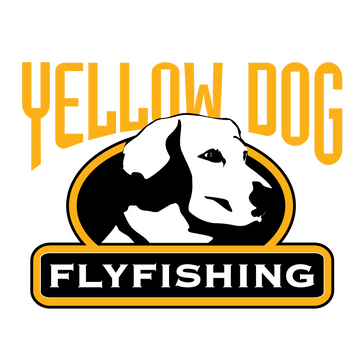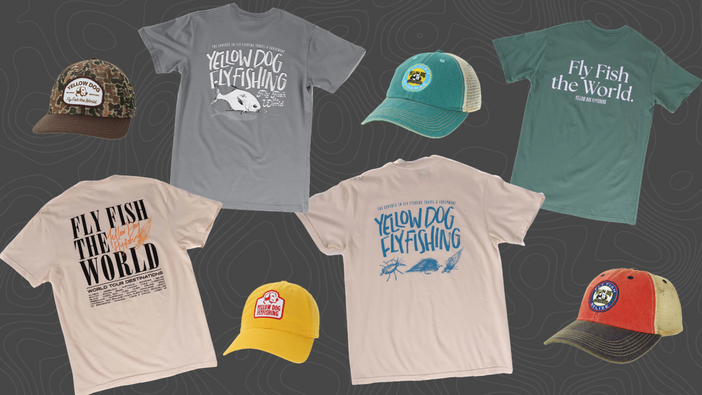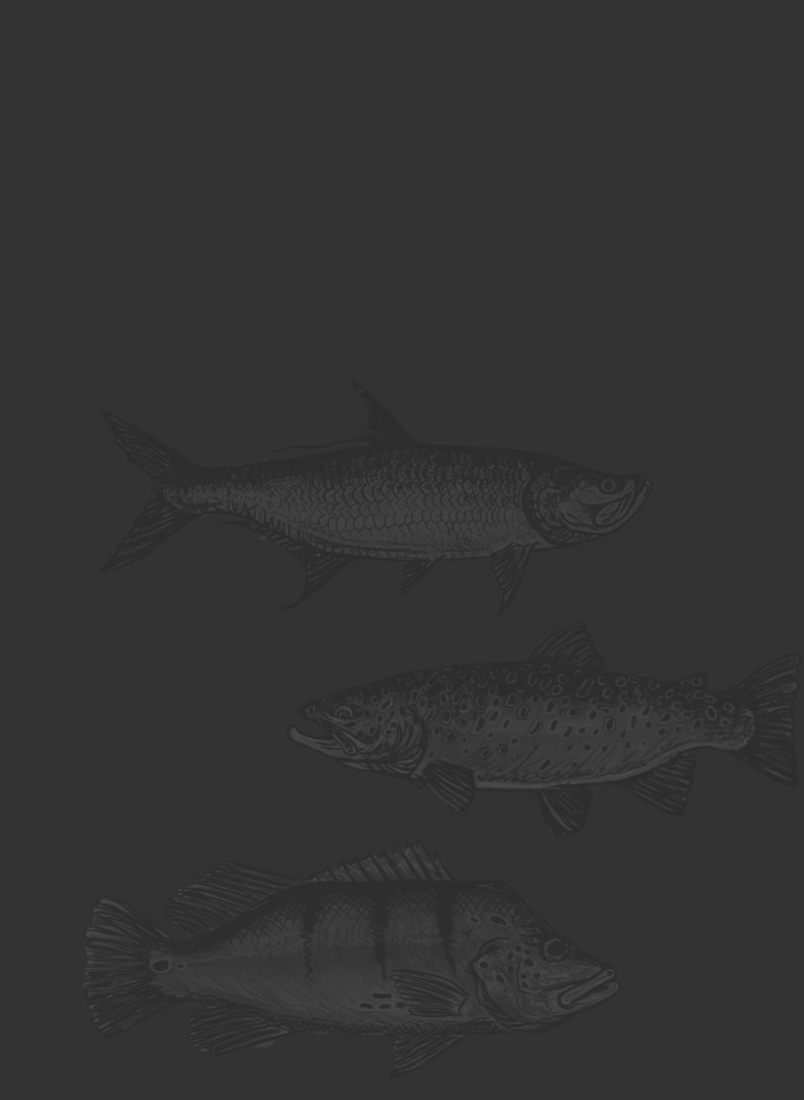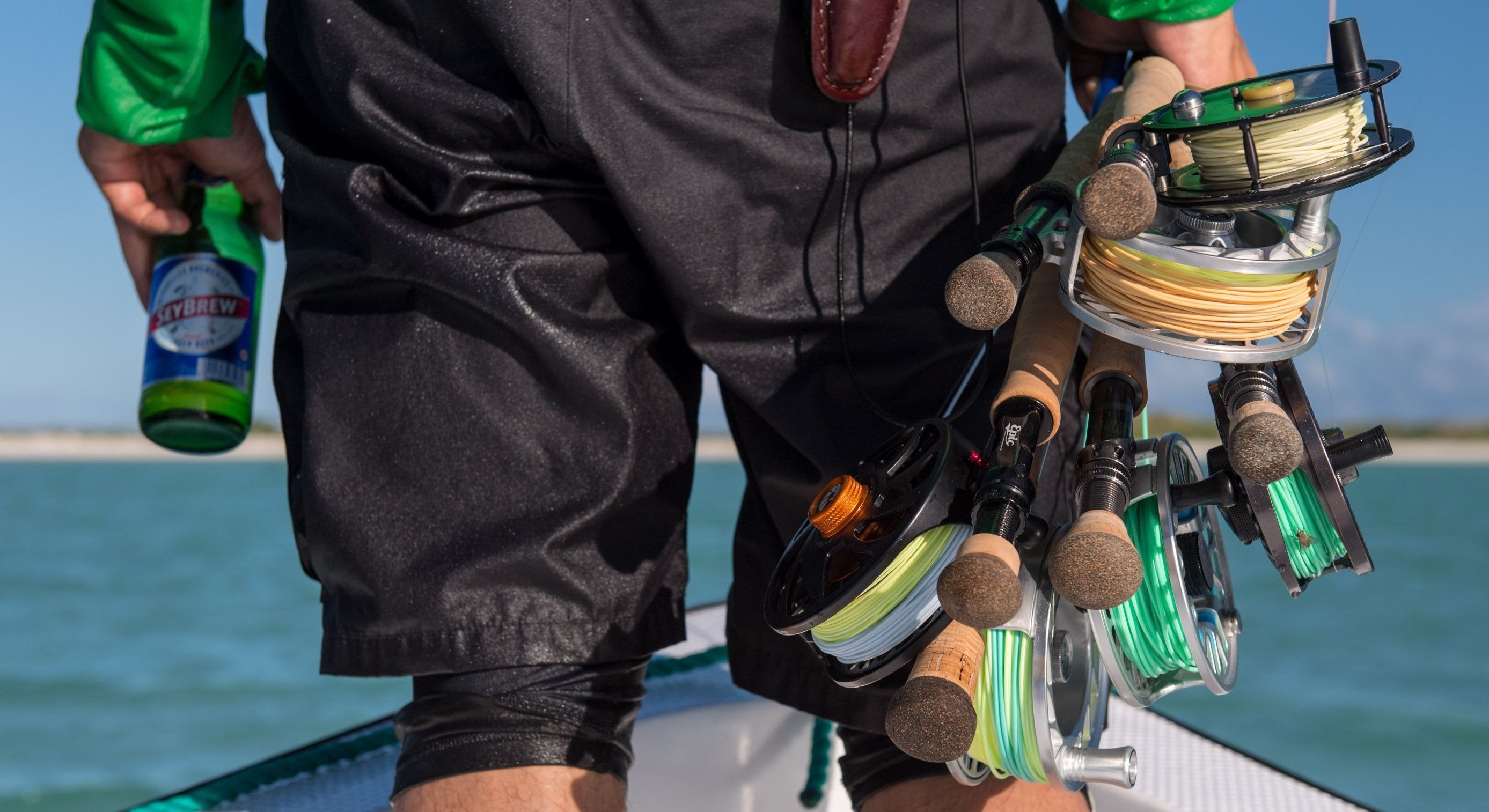If you have ever fly fished for permit, you are well aware of their finicky if not infuriating nature. Unpredictable, ultra-picky, and borderline paranoid, permit fishing brings us the highest highs and the lowest lows, driving many anglers mad with love, hate, and everything in between.
This article will look at 13 of the world's most popular, reliable permit flies for use around the world and regional considerations for planning your fly box.
1. Raghead Crab
The Raghead Crab is no secret to anyone within the world of saltwater fly fishing. It has caught tons of permit around the world, and is one of those permit patterns that should feature in your box no matter where you are headed. When stationary or slowly stripped, the splayed feathers at the back of the fly imitate a crab's claws in a defensive position.
The body of the raghead is traditionally sections of synthetic yarn glued together, but various substitutes are readily available and work well. Doug McKnight's ER Crab, short for Easy Raghead, utilizes furry foam and is faster and far less messy than the original. Likewise, mcfly foam, EP crab bodies, or crab coins are all possible substitutes, and some thrifty anglers utilize the leftover hides from craft fur. Whatever you choose, don't leave home without.
2. Alphlexo
Designed by Signature Umpqua Tyer Alec Gerbec during his time on Alphonse, the Alphlexo has quickly become a permit and triggerfish staple, as well as a killer pattern for big bonefish. The profile of the fly is perhaps the most realistic of any crab currently on the market, and continues to catch permit well beyond its origin point in the Seychelles.
The body is comprised of body tubing tied in at both ends, a product originally intended for use in large baitfish patterns for predatory fish such as pike or musky. The result is a durable, realistic body profile that is also hollow and incredibly light. The alphlexo comes in a ton of different varieties, and you should opt for whatever color closely matches the bottom of the intended fishery.
+ Waypoints Podcast: WIL FLACK: Feeding Permit – Tips and Techniques for Chasing the Black-Tailed Devil

A saltwater staple for bonefish, permit, and any species that eats shrimp. The use of shrimp versus a crab fly when targeting permit is going to vary, but they do have one big advantage. When fishing a crab, the fly is generally stripped very slow, ticked across the bottom, or in some cases, left alone entirely. This means that if there is any slack in your line, you may never even feel a permit eat your crab fly before it spits the hook.
With a shrimp pattern, you are often stripping the fly allowing you to maintain good tension, therefore making it much easier to know when the fish has committed.
The orange casing at the tail of the fly acts as a trigger point for hungry fish as it resembles the egg sac of a spawning shrimp. The fly comes in a number of colors, from white to olive, and is one of the best "crossover" flies when targeting bonefish, permit, or triggerfish on the same flats.
4. Avalon
The Avalon was created specifically for permit within Cuba, but it has proven to be a great pattern throughout the Caribbean. However, if you are heading to Cuba, it is very likely going to be one of the first flies your guide asks you to tie on for both permit and bonefish.
When stripped, the splayed pieces of rabbit strips on the Avalon undulate in the water, and the strips of pearl diamond braid ensure the fly gets noticed. The fly is generally quite heavy, but is well-balanced through the use of a keel.
The keel is a piece of monofilament tied in from the bend of the hook up to the eye, threaded with stainless steel beads. The result is a fly that does not spin when stripped, perhaps the single greatest giveaway to a curious permit that a fly is not worth committing to.
The Avalon comes in two weights, and we suggest having a couple of each for targeting fish on calm, shallow flats as well as deeper water for cruising fish.

5. EP Crab
Enrico Puglisi's EP Crab is a popular permit fly, and for good reason. The body of the pattern consists of synthetic EP fibers, that are durable and shed water well. The fibers are layered, making for a realistic mottled appearance in the water similar to a crab's camouflaged carapace. The back of the fly, or the "mouth," consists of marabou for good, natural movement and krystal flash for "feelers."
This style of crab was popularized by Del Brown's merkin, where a synthetic material is layered down the shank with x-wraps and then trimmed to shape. This is a big pattern to have for travel to the Yucatan, especially with the use of the chartreuse thread which most Mexican guides prefer for their permit flies.

The Strong Arm Merkin is a Dave Skok pattern designed in the Florida Keys. The pattern was a revolutionary pattern in the region and has since been delivering permit to hand all over the world.
The Strong Arm's defining feature is the chenille claw extending from the back end of the body. The claw, or strong arm, serves multiple purposes. Firstly and most obviously, the claw is a realistic representation of a crab in a defensive posture hoping to deter a predator or latch on to a fish lip that comes too close.
Secondly, and potentially more importantly, the claw acts as a keel for the fly--keeping it more balanced in the water column as it falls. The result is a fly that moves and looks very realistic, routinely fooling many a permit in the Keys and well beyond.

If you're heading to Belize, this fly should be in your box. Originally developed by the lauded Will Bauer for the flats of Southern Belize, this fly is responsible for hundreds of permit to hand.
The Flats Crab is generally tied with Mcfly Foam, a synthetic material used for egg patterns for trout fishing. The decision to use Mcfly Foam was a smart one, as the material is known for quickly absorbing water and ensuring the crab pattern sinks. As much of the fishing in Southern Belize is done for actively feeding, tailing permit, a fly that can land softly but sink fast is paramount to success.
Another notable feature of the Flats Crab is its realistic profile, with its large rubber legs and crab eyes positioned to imitate how crabs actually move: side to side. For fly tyers, the original Bauer legs are hard to come by, but rubber bands or large rubber legs work just fine.
+ View the Southern Belize Equipment List

Similar to the Spawning Shrimp, the Mantis is a great crossover pattern between bonefish and permit. The Mantis Shrimp catches bonefish everywhere it goes, and is going to be one of your guide's first choices when selecting a shrimp fly.
For fly tyers, the original Mantis Shrimp is a resourceful pattern with very little waste. When tying, use your fingers or a comb to tease out the shorter fibers at the base of the craft fur. Use the longer fibers for the "head" of the shrimp (tied at the back) and the shorter fibers to use in a dubbing loop for the body. The result is a slender but realistic looking shrimp profile. If preferred, you could always utilize a premade dubbing brush to build the body to get creative or for ease of tying.

Del Brown caught over FIVE hundred permit on fly throughout his lifetime, a feat that truly boggles the mind. His signature crab pattern may appear to be simple when compared to some modern patterns, but it was a revolutionary pattern when he first designed it decades ago and still catches permit today.
There are a couple signature elements of Del's Crab. First, the use of a chartreuse thread, an element that has become common across a number of permit flies. Secondly, the fly's rubber legs are marked with a red marker at the tips, capable of capturing a permit's attention without overdoing it.
10. Danger Muffin
Doug McKnight has tied a number of staple saltwater fly patterns, including the Crimp, Da Tingum, and the Homeslice.
The Danger Muffin is no different, and has taken the permit fishing community by storm. The Danger Muffin's body is super innovative, using a combination of deer hair and rabbit fur. The result is a super lifelike, mottled body that closely resembles a well-camouflaged crab.
The Danger Muffin uses a combination of chenille and synthetic crab claws to complete an incredibly realistic looking fly--especially when wet. Similar to the Flats Crab, the fly is tied to imitate a crab moving side to side when stripped. If you're heading to The Bahamas, Yucatan, or Belize, this should be a part of your arsenal.

11. Fleeing Crab
Cathy Beck's Fleeing Crab is another tried and true that has been around for quite a while. It is a fairly straightforward pattern to tie, starting with a pinch of brown and tan marabou near the bend of the hook offers plenty of natural movement.
The body of the Fleeing Crab uses synthetic EP Fibers in the merkin-style to create the body, paired with orange-tipped rubber legs. Similar to the original Merkin fly, the small bit of orange at the tips of the legs acts as an attractor. Carrying on tradition, the Fleeing Crab is generally tied with chartreuse thread.

12. Squimp
The Squimp is traditionally a bonefish pattern, but permit dig it, too. The biggest consideration to consider is that the Squimp is traditionally tied with beadchain for shallow water environments, though there are some lead eye variants. A unique attribute, the beadchain is tied closer to the bend of the hook to keep it level in the water column.
The Squimp is tied with a craft fur tail and wing, with chenille wrapped down the shank. When wet, the Squimp has a slim profile, but the fly's rubber legs offer an abundance of movement and are uncharacteristically tied in on the side. The result is plenty of wiggle when stripped, and feeding fish tend to take notice.

13. Pato's Crab
One could argue Pato's Crab is simply a Raghead variant, and that argument is probably correct. However, there are minor details that a Yucatan or Belizean guide are going to look for that differentiate the original Raghead and Pato's Crab.
Pato's Crab was tied in the Ascension Bay area by a local guide, and quickly became many Yucatan guide's go-to fly. The most notable detail of Pato's Crab is the addition of colored lead eyes, most typically yellow. The lead eyes are both heavier and act as an attention-grabber for cruising and tailing fish.
Pato's Crab is super popular amongst a lot of guides around the Yucatan, though this pattern is great for permit fishing around the entire world. Red, orange, and pink eyes are also used, but yellow is often the most preferred. Strip this fly slow or else it will spin in the water, a dead giveaway that something is awry!
Wherever you are headed to chase permit, the Yellow Dog fly shop has hand-picked fly assortments to ensure you arrive ready on the morning of day one.
Recommended Gear Guides:
Related Articles:
- 8 Destinations for the Serious Permit Angler
- Top 5 Spots for Your First Permit
- The 16 Rules of How to Feed Permit
- 7 Tips for Fly Fishing for Permit
- Saltwater Fly Fishing Leader & Tippet Guide
- Watch: Fly Fishing for Permit | Seychelles Fishing Tactics






























